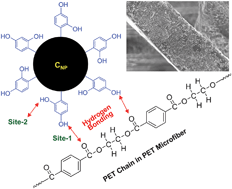Resorcinol-functionalized carbon nanoparticles with a stick-out nanostructure for stable hydrogen bonding with polyester microfibers†
Abstract
We report new functionalized carbon nanoparticles (CNPs) featuring a stick-out nanostructure that delivers strong hydrogen bonding with polar groups in polymer chains. To make the stick-out nanostructures with hydroxyl groups, bromoresorcinols were used to react with the double bonds of CNPs by atom transfer radical reaction (ATRR). The resorcinol-bound CNPs (CNP-RCs) were characterized by solid-state proton nuclear magnetic spectroscopy and Raman spectroscopy. CNP-RCs were extremely well dispersed and stable (>6 months) compared to the original CNPs which precipitated in less than 60 h. High resolution transmission electron microscopy measurements disclosed that the characteristic particle shape and fine nanostructure of the original CNPs were almost unchanged during the ATRR process. We found that the surface of poly(ethylene terephthalate) (PET) microfibers was almost fully covered with the CNP-RC material by employing a double soaking process at 130 °C. The resulting CNP-RC-bound PET microfibers in fabrics exhibited excellent washing and rubbing resistance and outstanding deodorizing properties against ammonia gas. Hence, the present stick-out nanostructured CNP-RCs are expected to be a breakthrough in widening the application of carbon nanoparticles in terms of environmentally friendly processes using water and product-level stability.


 Please wait while we load your content...
Please wait while we load your content...